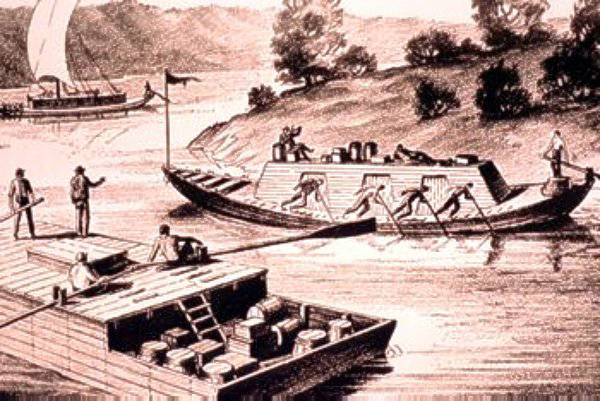Pittsburgh, PA As Lewis waits for his barge to be completed, Pittsburgh’s role in western commerce is explained, and flatboats and keelboats are compared.
Above: A flatboat floats down the river while a keelboat is poled against the current.
Western Commerce
[Pittsburgh] has lost its importance as a military post, it has acquired a still greater one in respect to commerce. It serves as a staple for the different sorts of merchandise that Philadelphia and Baltimore send, in the beginning of spring and autumn, for supplying the states of Ohio, Kentucky, and the settlement of Natches.
—François André Michaux[1]François André Michaux, Travels to the West of the Alleghany Mountains (1805 reprint from London edition), p. 60 in Reuben G. Thwaites, Travels West of the Alleghanies (Cleveland: The Arthur H. … Continue reading
Flatboats v. Keelboats
Timothy Flint, after his own trip down the Ohio River in 1815, describes four types of boats used on the river. Here, the flatboat and keelboat are presented:
. . . . there is the keel-boat, of a long, slender, and elegant form, and generally carrying from fifteen to thirty tons. This boat is formed to be easily propelled over shallow waters in the summer season, and in low stages of the water is still much used, and runs on waters not yet frequented by steam-boats.
Next in order are the Kentucky flats, or in the vernacular phrase, “broad horns,” a species of ark, very nearly resembling a New England pig-stye. They are fifteen feet wide, and from forty to one hundred feet in length, and carry from twenty to seventy tons. Some of them, that are called family-boats, and used by families in descending the river, are very large and roomy, and have comfortable and separate apartments, fitted up with, chairs, beds, tables and stores. It is no uncommon spectacle to see a large family, old and young, servants, cattle, hogs, horses, sheep, fowls, and animals of all kinds bringing to recollections the cargo of the ancient ark, all embarked, and floating down on the same bottom.[2]Timothy Flint, Recollections of the Last Ten Years, Passed in Occasional Residences and Journeyings in the Valley the Mississippi, from Pittsburg and the Missouri to the Gulf of Mexico, from Florida … Continue reading
The boat being built in Pittsburgh for Lewis on this date was not a keelboat as is it is widely called today. At the time of the Lewis and Clark Expedition, it was called the barge—not only by the expedition journalists but by the many people indirectly involved at the time. The keelboat moniker was mis-applied to the barge by later historians. For Flint’s description of a barge, see August 6, 1803.
Notes
| ↑1 | François André Michaux, Travels to the West of the Alleghany Mountains (1805 reprint from London edition), p. 60 in Reuben G. Thwaites, Travels West of the Alleghanies (Cleveland: The Arthur H. Clark Co., 1904), p. 157–8. |
|---|---|
| ↑2 | Timothy Flint, Recollections of the Last Ten Years, Passed in Occasional Residences and Journeyings in the Valley the Mississippi, from Pittsburg and the Missouri to the Gulf of Mexico, from Florida to the Spanish Frontier. . . (Boston: Cummings, Hilliard, and Company, 1826), 13–14. |

